Enhancement of PCM Performance by Graphite & Al2O3 Particles Study
VerifiedAdded on 2023/06/10
|10
|3690
|472
Project
AI Summary
This project investigates the enhancement of phase change materials (PCMs) for thermal energy storage (TES) using graphite and aluminum oxide (Al2O3) reinforcement. The study focuses on calcium nitrate tetra-hydrate (Ca(NO3)2•4H2O) and examines the impact of varying weight percentages of graphite and Al2O3 on its properties. Experiments revealed that a 7.5% graphite and 2.5% Al2O3 combination results in higher latent heat and minimal mass loss, while a 5% graphite and 5% Al2O3 mix improves thermal conductivity. The research concludes that these reinforcements can significantly enhance the thermal storage capacity and efficiency of PCMs compared to conventional materials, making them more suitable for renewable energy applications in buildings and other industries. The literature review supports the study by discussing the use of PCM in building materials and various methods to determine the effective use of these materials.
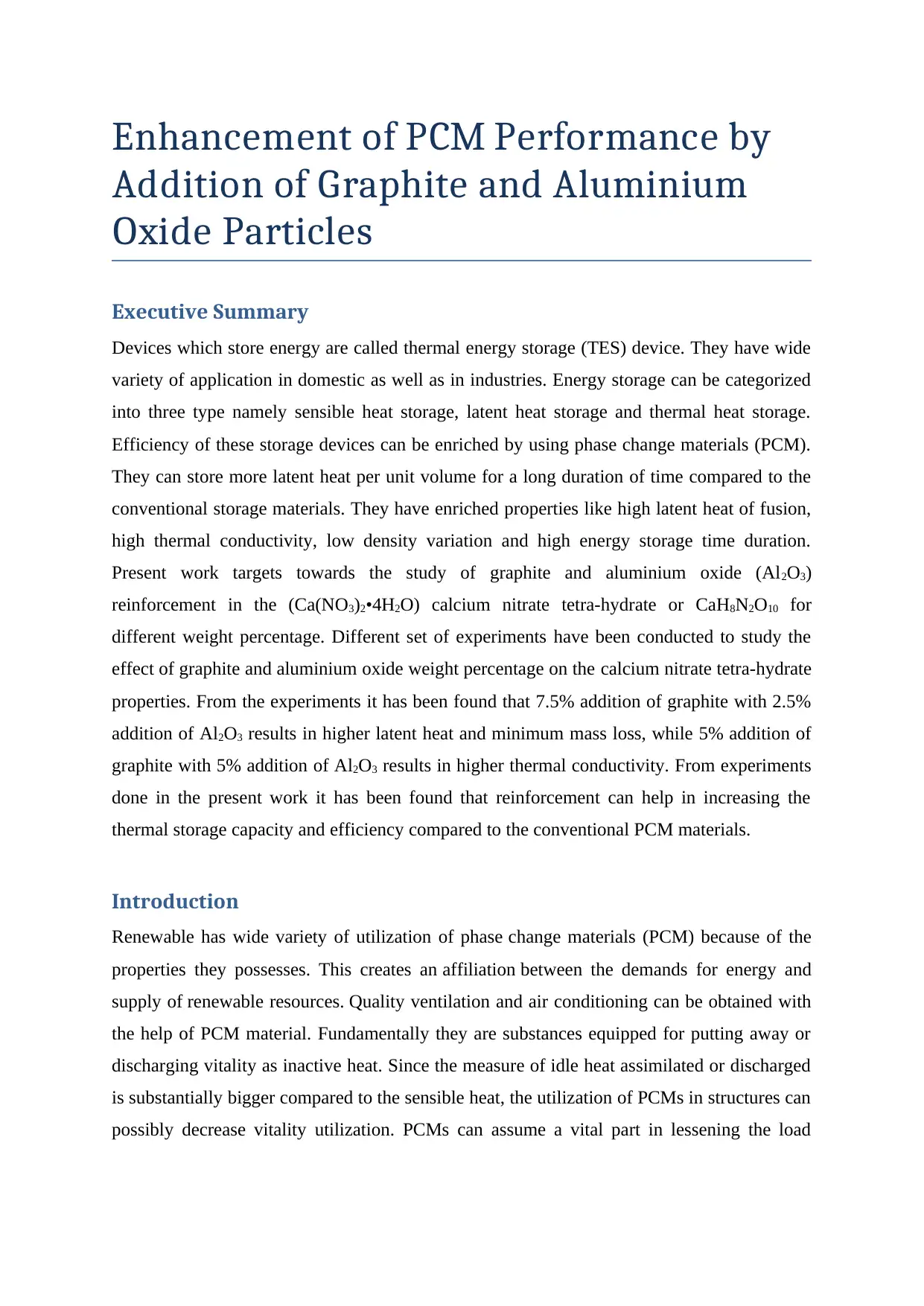
Enhancement of PCM Performance by
Addition of Graphite and Aluminium
Oxide Particles
Executive Summary
Devices which store energy are called thermal energy storage (TES) device. They have wide
variety of application in domestic as well as in industries. Energy storage can be categorized
into three type namely sensible heat storage, latent heat storage and thermal heat storage.
Efficiency of these storage devices can be enriched by using phase change materials (PCM).
They can store more latent heat per unit volume for a long duration of time compared to the
conventional storage materials. They have enriched properties like high latent heat of fusion,
high thermal conductivity, low density variation and high energy storage time duration.
Present work targets towards the study of graphite and aluminium oxide (Al2O3)
reinforcement in the (Ca(NO3)2•4H2O) calcium nitrate tetra-hydrate or CaH8N2O10 for
different weight percentage. Different set of experiments have been conducted to study the
effect of graphite and aluminium oxide weight percentage on the calcium nitrate tetra-hydrate
properties. From the experiments it has been found that 7.5% addition of graphite with 2.5%
addition of Al2O3 results in higher latent heat and minimum mass loss, while 5% addition of
graphite with 5% addition of Al2O3 results in higher thermal conductivity. From experiments
done in the present work it has been found that reinforcement can help in increasing the
thermal storage capacity and efficiency compared to the conventional PCM materials.
Introduction
Renewable has wide variety of utilization of phase change materials (PCM) because of the
properties they possesses. This creates an affiliation between the demands for energy and
supply of renewable resources. Quality ventilation and air conditioning can be obtained with
the help of PCM material. Fundamentally they are substances equipped for putting away or
discharging vitality as inactive heat. Since the measure of idle heat assimilated or discharged
is substantially bigger compared to the sensible heat, the utilization of PCMs in structures can
possibly decrease vitality utilization. PCMs can assume a vital part in lessening the load
Addition of Graphite and Aluminium
Oxide Particles
Executive Summary
Devices which store energy are called thermal energy storage (TES) device. They have wide
variety of application in domestic as well as in industries. Energy storage can be categorized
into three type namely sensible heat storage, latent heat storage and thermal heat storage.
Efficiency of these storage devices can be enriched by using phase change materials (PCM).
They can store more latent heat per unit volume for a long duration of time compared to the
conventional storage materials. They have enriched properties like high latent heat of fusion,
high thermal conductivity, low density variation and high energy storage time duration.
Present work targets towards the study of graphite and aluminium oxide (Al2O3)
reinforcement in the (Ca(NO3)2•4H2O) calcium nitrate tetra-hydrate or CaH8N2O10 for
different weight percentage. Different set of experiments have been conducted to study the
effect of graphite and aluminium oxide weight percentage on the calcium nitrate tetra-hydrate
properties. From the experiments it has been found that 7.5% addition of graphite with 2.5%
addition of Al2O3 results in higher latent heat and minimum mass loss, while 5% addition of
graphite with 5% addition of Al2O3 results in higher thermal conductivity. From experiments
done in the present work it has been found that reinforcement can help in increasing the
thermal storage capacity and efficiency compared to the conventional PCM materials.
Introduction
Renewable has wide variety of utilization of phase change materials (PCM) because of the
properties they possesses. This creates an affiliation between the demands for energy and
supply of renewable resources. Quality ventilation and air conditioning can be obtained with
the help of PCM material. Fundamentally they are substances equipped for putting away or
discharging vitality as inactive heat. Since the measure of idle heat assimilated or discharged
is substantially bigger compared to the sensible heat, the utilization of PCMs in structures can
possibly decrease vitality utilization. PCMs can assume a vital part in lessening the load
Paraphrase This Document
Need a fresh take? Get an instant paraphrase of this document with our AI Paraphraser
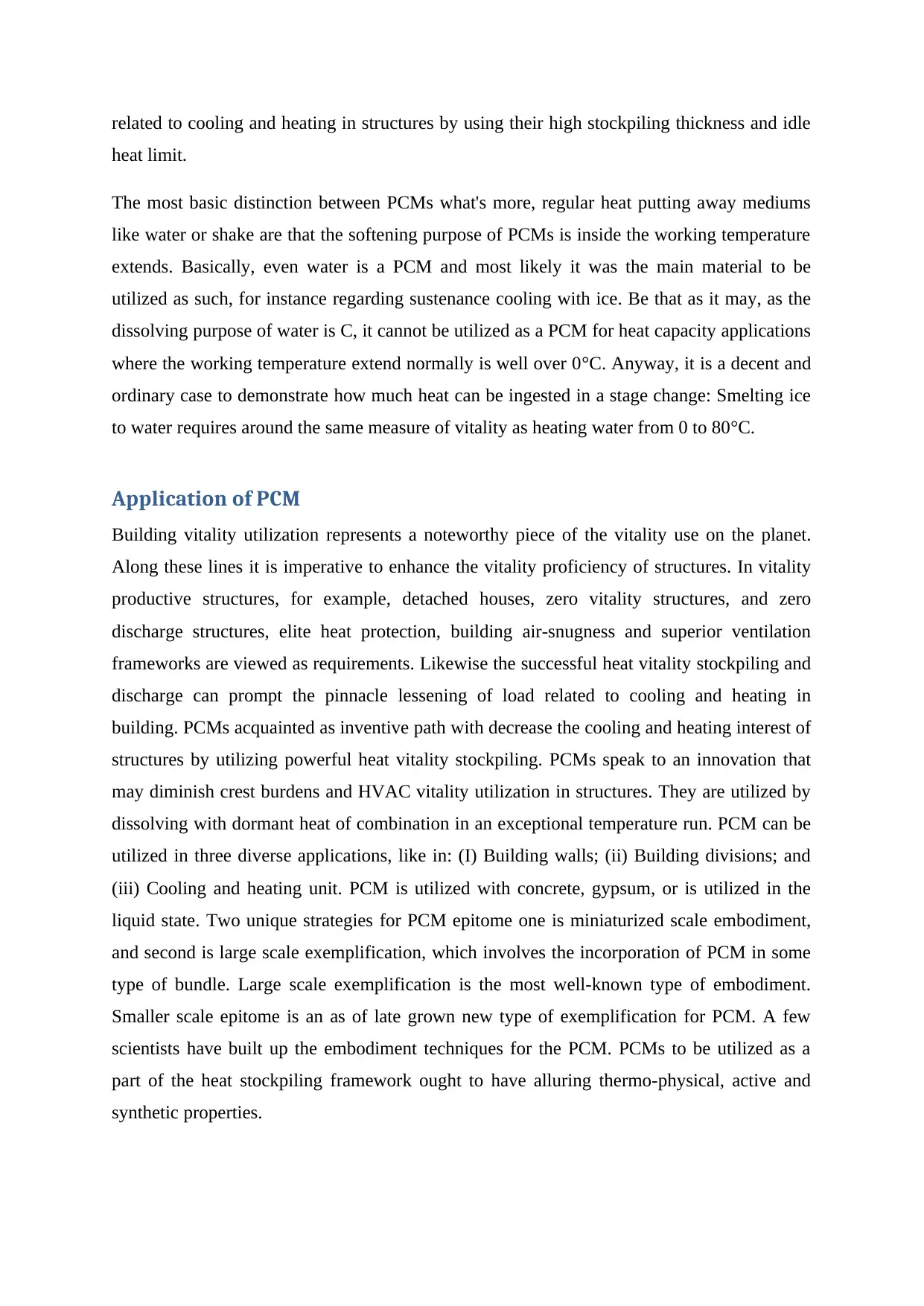
related to cooling and heating in structures by using their high stockpiling thickness and idle
heat limit.
The most basic distinction between PCMs what's more, regular heat putting away mediums
like water or shake are that the softening purpose of PCMs is inside the working temperature
extends. Basically, even water is a PCM and most likely it was the main material to be
utilized as such, for instance regarding sustenance cooling with ice. Be that as it may, as the
dissolving purpose of water is C, it cannot be utilized as a PCM for heat capacity applications
where the working temperature extend normally is well over 0°C. Anyway, it is a decent and
ordinary case to demonstrate how much heat can be ingested in a stage change: Smelting ice
to water requires around the same measure of vitality as heating water from 0 to 80°C.
Application of PCM
Building vitality utilization represents a noteworthy piece of the vitality use on the planet.
Along these lines it is imperative to enhance the vitality proficiency of structures. In vitality
productive structures, for example, detached houses, zero vitality structures, and zero
discharge structures, elite heat protection, building air-snugness and superior ventilation
frameworks are viewed as requirements. Likewise the successful heat vitality stockpiling and
discharge can prompt the pinnacle lessening of load related to cooling and heating in
building. PCMs acquainted as inventive path with decrease the cooling and heating interest of
structures by utilizing powerful heat vitality stockpiling. PCMs speak to an innovation that
may diminish crest burdens and HVAC vitality utilization in structures. They are utilized by
dissolving with dormant heat of combination in an exceptional temperature run. PCM can be
utilized in three diverse applications, like in: (I) Building walls; (ii) Building divisions; and
(iii) Cooling and heating unit. PCM is utilized with concrete, gypsum, or is utilized in the
liquid state. Two unique strategies for PCM epitome one is miniaturized scale embodiment,
and second is large scale exemplification, which involves the incorporation of PCM in some
type of bundle. Large scale exemplification is the most well-known type of embodiment.
Smaller scale epitome is an as of late grown new type of exemplification for PCM. A few
scientists have built up the embodiment techniques for the PCM. PCMs to be utilized as a
part of the heat stockpiling framework ought to have alluring thermo-physical, active and
synthetic properties.
heat limit.
The most basic distinction between PCMs what's more, regular heat putting away mediums
like water or shake are that the softening purpose of PCMs is inside the working temperature
extends. Basically, even water is a PCM and most likely it was the main material to be
utilized as such, for instance regarding sustenance cooling with ice. Be that as it may, as the
dissolving purpose of water is C, it cannot be utilized as a PCM for heat capacity applications
where the working temperature extend normally is well over 0°C. Anyway, it is a decent and
ordinary case to demonstrate how much heat can be ingested in a stage change: Smelting ice
to water requires around the same measure of vitality as heating water from 0 to 80°C.
Application of PCM
Building vitality utilization represents a noteworthy piece of the vitality use on the planet.
Along these lines it is imperative to enhance the vitality proficiency of structures. In vitality
productive structures, for example, detached houses, zero vitality structures, and zero
discharge structures, elite heat protection, building air-snugness and superior ventilation
frameworks are viewed as requirements. Likewise the successful heat vitality stockpiling and
discharge can prompt the pinnacle lessening of load related to cooling and heating in
building. PCMs acquainted as inventive path with decrease the cooling and heating interest of
structures by utilizing powerful heat vitality stockpiling. PCMs speak to an innovation that
may diminish crest burdens and HVAC vitality utilization in structures. They are utilized by
dissolving with dormant heat of combination in an exceptional temperature run. PCM can be
utilized in three diverse applications, like in: (I) Building walls; (ii) Building divisions; and
(iii) Cooling and heating unit. PCM is utilized with concrete, gypsum, or is utilized in the
liquid state. Two unique strategies for PCM epitome one is miniaturized scale embodiment,
and second is large scale exemplification, which involves the incorporation of PCM in some
type of bundle. Large scale exemplification is the most well-known type of embodiment.
Smaller scale epitome is an as of late grown new type of exemplification for PCM. A few
scientists have built up the embodiment techniques for the PCM. PCMs to be utilized as a
part of the heat stockpiling framework ought to have alluring thermo-physical, active and
synthetic properties.
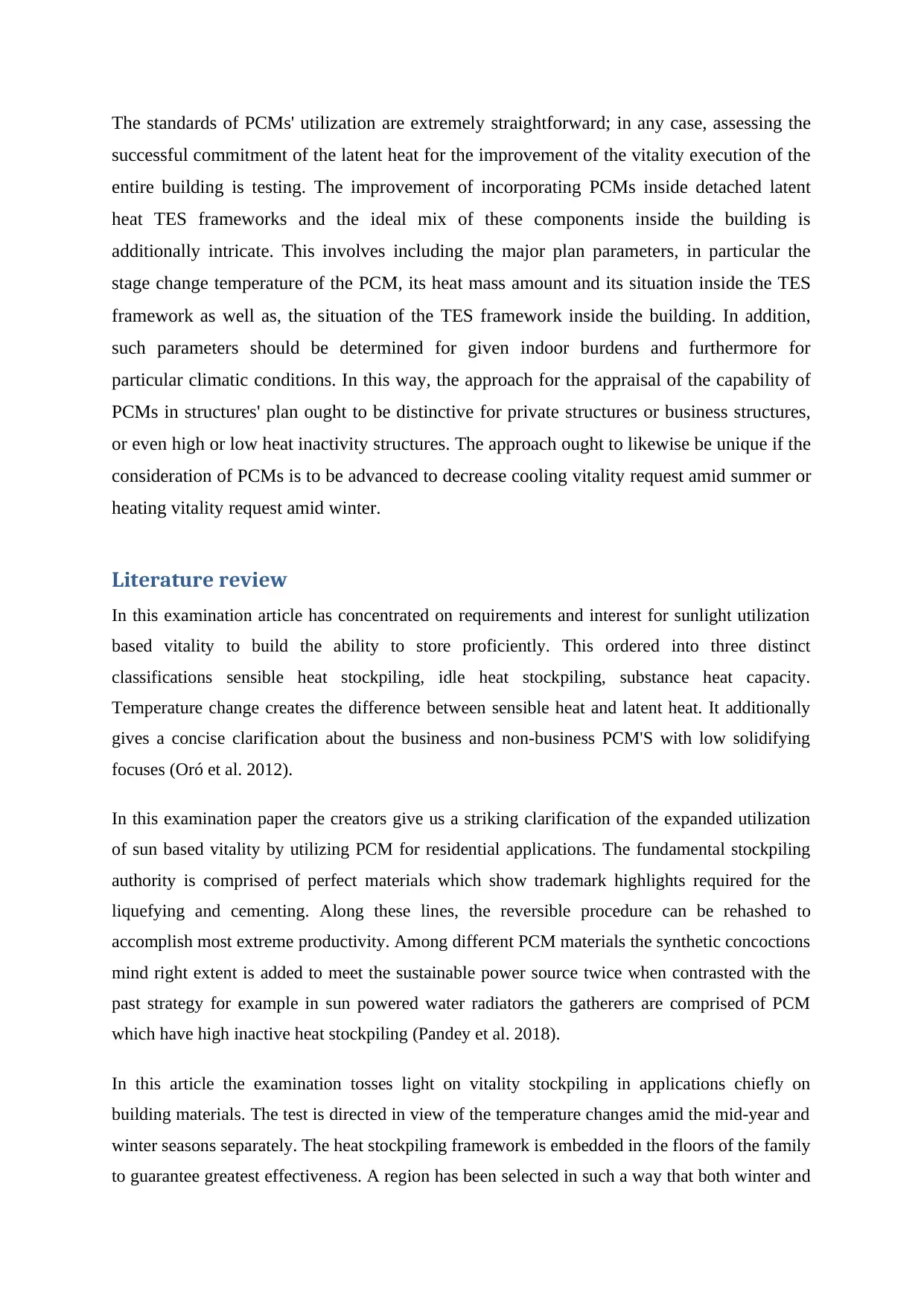
The standards of PCMs' utilization are extremely straightforward; in any case, assessing the
successful commitment of the latent heat for the improvement of the vitality execution of the
entire building is testing. The improvement of incorporating PCMs inside detached latent
heat TES frameworks and the ideal mix of these components inside the building is
additionally intricate. This involves including the major plan parameters, in particular the
stage change temperature of the PCM, its heat mass amount and its situation inside the TES
framework as well as, the situation of the TES framework inside the building. In addition,
such parameters should be determined for given indoor burdens and furthermore for
particular climatic conditions. In this way, the approach for the appraisal of the capability of
PCMs in structures' plan ought to be distinctive for private structures or business structures,
or even high or low heat inactivity structures. The approach ought to likewise be unique if the
consideration of PCMs is to be advanced to decrease cooling vitality request amid summer or
heating vitality request amid winter.
Literature review
In this examination article has concentrated on requirements and interest for sunlight utilization
based vitality to build the ability to store proficiently. This ordered into three distinct
classifications sensible heat stockpiling, idle heat stockpiling, substance heat capacity.
Temperature change creates the difference between sensible heat and latent heat. It additionally
gives a concise clarification about the business and non-business PCM'S with low solidifying
focuses (Oró et al. 2012).
In this examination paper the creators give us a striking clarification of the expanded utilization
of sun based vitality by utilizing PCM for residential applications. The fundamental stockpiling
authority is comprised of perfect materials which show trademark highlights required for the
liquefying and cementing. Along these lines, the reversible procedure can be rehashed to
accomplish most extreme productivity. Among different PCM materials the synthetic concoctions
mind right extent is added to meet the sustainable power source twice when contrasted with the
past strategy for example in sun powered water radiators the gatherers are comprised of PCM
which have high inactive heat stockpiling (Pandey et al. 2018).
In this article the examination tosses light on vitality stockpiling in applications chiefly on
building materials. The test is directed in view of the temperature changes amid the mid-year and
winter seasons separately. The heat stockpiling framework is embedded in the floors of the family
to guarantee greatest effectiveness. A region has been selected in such a way that both winter and
successful commitment of the latent heat for the improvement of the vitality execution of the
entire building is testing. The improvement of incorporating PCMs inside detached latent
heat TES frameworks and the ideal mix of these components inside the building is
additionally intricate. This involves including the major plan parameters, in particular the
stage change temperature of the PCM, its heat mass amount and its situation inside the TES
framework as well as, the situation of the TES framework inside the building. In addition,
such parameters should be determined for given indoor burdens and furthermore for
particular climatic conditions. In this way, the approach for the appraisal of the capability of
PCMs in structures' plan ought to be distinctive for private structures or business structures,
or even high or low heat inactivity structures. The approach ought to likewise be unique if the
consideration of PCMs is to be advanced to decrease cooling vitality request amid summer or
heating vitality request amid winter.
Literature review
In this examination article has concentrated on requirements and interest for sunlight utilization
based vitality to build the ability to store proficiently. This ordered into three distinct
classifications sensible heat stockpiling, idle heat stockpiling, substance heat capacity.
Temperature change creates the difference between sensible heat and latent heat. It additionally
gives a concise clarification about the business and non-business PCM'S with low solidifying
focuses (Oró et al. 2012).
In this examination paper the creators give us a striking clarification of the expanded utilization
of sun based vitality by utilizing PCM for residential applications. The fundamental stockpiling
authority is comprised of perfect materials which show trademark highlights required for the
liquefying and cementing. Along these lines, the reversible procedure can be rehashed to
accomplish most extreme productivity. Among different PCM materials the synthetic concoctions
mind right extent is added to meet the sustainable power source twice when contrasted with the
past strategy for example in sun powered water radiators the gatherers are comprised of PCM
which have high inactive heat stockpiling (Pandey et al. 2018).
In this article the examination tosses light on vitality stockpiling in applications chiefly on
building materials. The test is directed in view of the temperature changes amid the mid-year and
winter seasons separately. The heat stockpiling framework is embedded in the floors of the family
to guarantee greatest effectiveness. A region has been selected in such a way that both winter and
⊘ This is a preview!⊘
Do you want full access?
Subscribe today to unlock all pages.

Trusted by 1+ million students worldwide
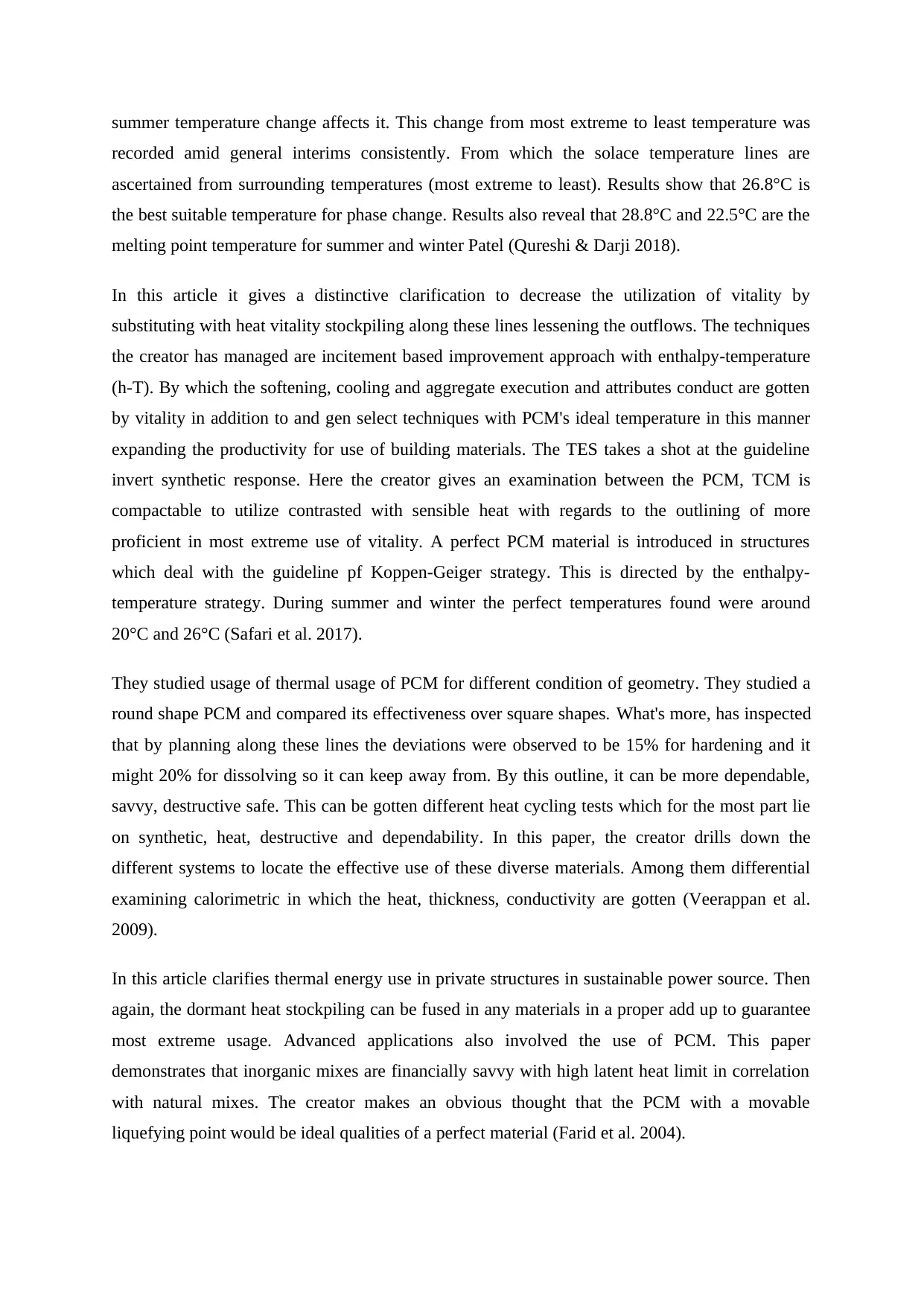
summer temperature change affects it. This change from most extreme to least temperature was
recorded amid general interims consistently. From which the solace temperature lines are
ascertained from surrounding temperatures (most extreme to least). Results show that 26.8°C is
the best suitable temperature for phase change. Results also reveal that 28.8°C and 22.5°C are the
melting point temperature for summer and winter Patel (Qureshi & Darji 2018).
In this article it gives a distinctive clarification to decrease the utilization of vitality by
substituting with heat vitality stockpiling along these lines lessening the outflows. The techniques
the creator has managed are incitement based improvement approach with enthalpy-temperature
(h-T). By which the softening, cooling and aggregate execution and attributes conduct are gotten
by vitality in addition to and gen select techniques with PCM's ideal temperature in this manner
expanding the productivity for use of building materials. The TES takes a shot at the guideline
invert synthetic response. Here the creator gives an examination between the PCM, TCM is
compactable to utilize contrasted with sensible heat with regards to the outlining of more
proficient in most extreme use of vitality. A perfect PCM material is introduced in structures
which deal with the guideline pf Koppen-Geiger strategy. This is directed by the enthalpy-
temperature strategy. During summer and winter the perfect temperatures found were around
20°C and 26°C (Safari et al. 2017).
They studied usage of thermal usage of PCM for different condition of geometry. They studied a
round shape PCM and compared its effectiveness over square shapes. What's more, has inspected
that by planning along these lines the deviations were observed to be 15% for hardening and it
might 20% for dissolving so it can keep away from. By this outline, it can be more dependable,
savvy, destructive safe. This can be gotten different heat cycling tests which for the most part lie
on synthetic, heat, destructive and dependability. In this paper, the creator drills down the
different systems to locate the effective use of these diverse materials. Among them differential
examining calorimetric in which the heat, thickness, conductivity are gotten (Veerappan et al.
2009).
In this article clarifies thermal energy use in private structures in sustainable power source. Then
again, the dormant heat stockpiling can be fused in any materials in a proper add up to guarantee
most extreme usage. Advanced applications also involved the use of PCM. This paper
demonstrates that inorganic mixes are financially savvy with high latent heat limit in correlation
with natural mixes. The creator makes an obvious thought that the PCM with a movable
liquefying point would be ideal qualities of a perfect material (Farid et al. 2004).
recorded amid general interims consistently. From which the solace temperature lines are
ascertained from surrounding temperatures (most extreme to least). Results show that 26.8°C is
the best suitable temperature for phase change. Results also reveal that 28.8°C and 22.5°C are the
melting point temperature for summer and winter Patel (Qureshi & Darji 2018).
In this article it gives a distinctive clarification to decrease the utilization of vitality by
substituting with heat vitality stockpiling along these lines lessening the outflows. The techniques
the creator has managed are incitement based improvement approach with enthalpy-temperature
(h-T). By which the softening, cooling and aggregate execution and attributes conduct are gotten
by vitality in addition to and gen select techniques with PCM's ideal temperature in this manner
expanding the productivity for use of building materials. The TES takes a shot at the guideline
invert synthetic response. Here the creator gives an examination between the PCM, TCM is
compactable to utilize contrasted with sensible heat with regards to the outlining of more
proficient in most extreme use of vitality. A perfect PCM material is introduced in structures
which deal with the guideline pf Koppen-Geiger strategy. This is directed by the enthalpy-
temperature strategy. During summer and winter the perfect temperatures found were around
20°C and 26°C (Safari et al. 2017).
They studied usage of thermal usage of PCM for different condition of geometry. They studied a
round shape PCM and compared its effectiveness over square shapes. What's more, has inspected
that by planning along these lines the deviations were observed to be 15% for hardening and it
might 20% for dissolving so it can keep away from. By this outline, it can be more dependable,
savvy, destructive safe. This can be gotten different heat cycling tests which for the most part lie
on synthetic, heat, destructive and dependability. In this paper, the creator drills down the
different systems to locate the effective use of these diverse materials. Among them differential
examining calorimetric in which the heat, thickness, conductivity are gotten (Veerappan et al.
2009).
In this article clarifies thermal energy use in private structures in sustainable power source. Then
again, the dormant heat stockpiling can be fused in any materials in a proper add up to guarantee
most extreme usage. Advanced applications also involved the use of PCM. This paper
demonstrates that inorganic mixes are financially savvy with high latent heat limit in correlation
with natural mixes. The creator makes an obvious thought that the PCM with a movable
liquefying point would be ideal qualities of a perfect material (Farid et al. 2004).
Paraphrase This Document
Need a fresh take? Get an instant paraphrase of this document with our AI Paraphraser
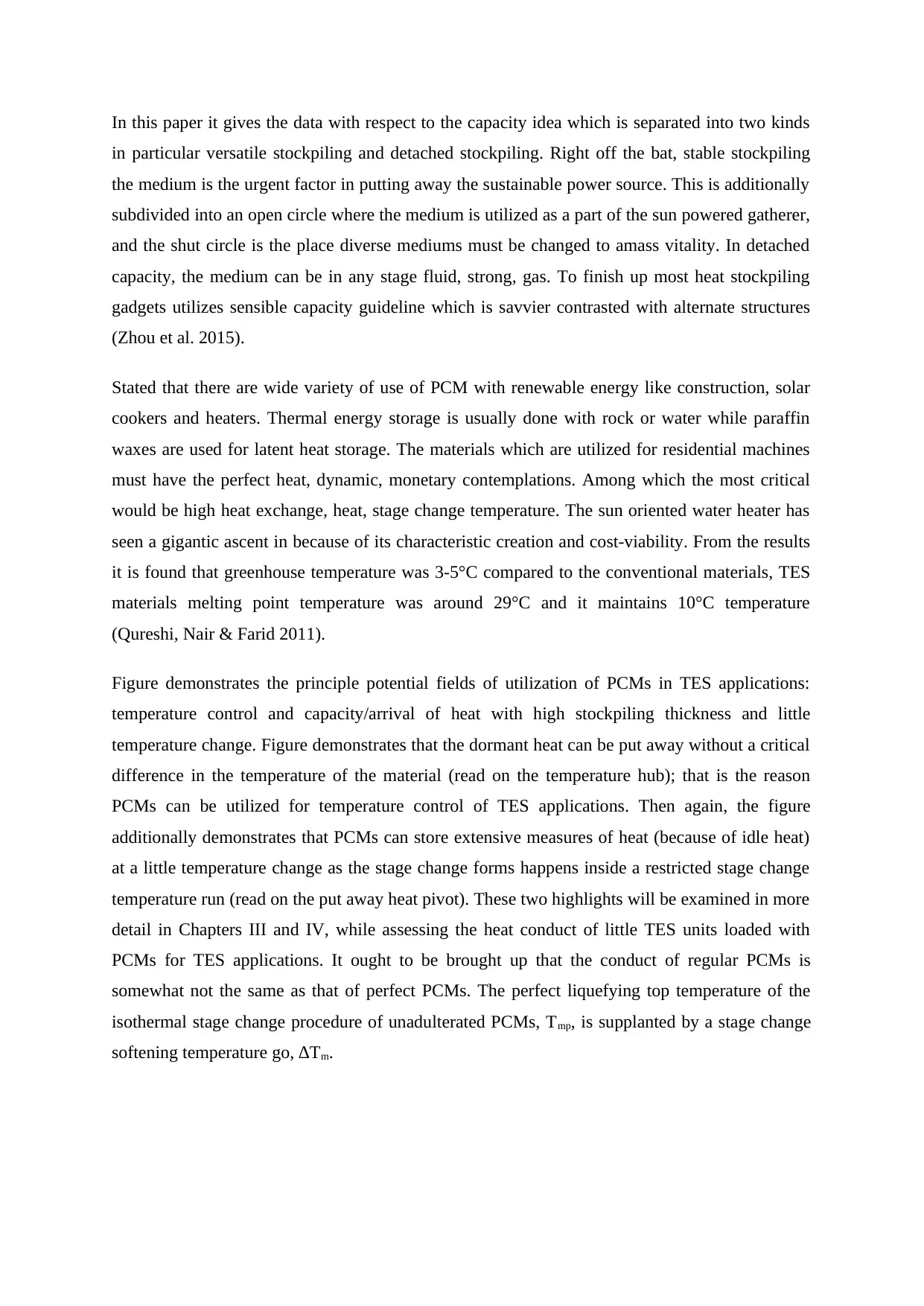
In this paper it gives the data with respect to the capacity idea which is separated into two kinds
in particular versatile stockpiling and detached stockpiling. Right off the bat, stable stockpiling
the medium is the urgent factor in putting away the sustainable power source. This is additionally
subdivided into an open circle where the medium is utilized as a part of the sun powered gatherer,
and the shut circle is the place diverse mediums must be changed to amass vitality. In detached
capacity, the medium can be in any stage fluid, strong, gas. To finish up most heat stockpiling
gadgets utilizes sensible capacity guideline which is savvier contrasted with alternate structures
(Zhou et al. 2015).
Stated that there are wide variety of use of PCM with renewable energy like construction, solar
cookers and heaters. Thermal energy storage is usually done with rock or water while paraffin
waxes are used for latent heat storage. The materials which are utilized for residential machines
must have the perfect heat, dynamic, monetary contemplations. Among which the most critical
would be high heat exchange, heat, stage change temperature. The sun oriented water heater has
seen a gigantic ascent in because of its characteristic creation and cost-viability. From the results
it is found that greenhouse temperature was 3-5°C compared to the conventional materials, TES
materials melting point temperature was around 29°C and it maintains 10°C temperature
(Qureshi, Nair & Farid 2011).
Figure demonstrates the principle potential fields of utilization of PCMs in TES applications:
temperature control and capacity/arrival of heat with high stockpiling thickness and little
temperature change. Figure demonstrates that the dormant heat can be put away without a critical
difference in the temperature of the material (read on the temperature hub); that is the reason
PCMs can be utilized for temperature control of TES applications. Then again, the figure
additionally demonstrates that PCMs can store extensive measures of heat (because of idle heat)
at a little temperature change as the stage change forms happens inside a restricted stage change
temperature run (read on the put away heat pivot). These two highlights will be examined in more
detail in Chapters III and IV, while assessing the heat conduct of little TES units loaded with
PCMs for TES applications. It ought to be brought up that the conduct of regular PCMs is
somewhat not the same as that of perfect PCMs. The perfect liquefying top temperature of the
isothermal stage change procedure of unadulterated PCMs, Tmp, is supplanted by a stage change
softening temperature go, ∆Tm.
in particular versatile stockpiling and detached stockpiling. Right off the bat, stable stockpiling
the medium is the urgent factor in putting away the sustainable power source. This is additionally
subdivided into an open circle where the medium is utilized as a part of the sun powered gatherer,
and the shut circle is the place diverse mediums must be changed to amass vitality. In detached
capacity, the medium can be in any stage fluid, strong, gas. To finish up most heat stockpiling
gadgets utilizes sensible capacity guideline which is savvier contrasted with alternate structures
(Zhou et al. 2015).
Stated that there are wide variety of use of PCM with renewable energy like construction, solar
cookers and heaters. Thermal energy storage is usually done with rock or water while paraffin
waxes are used for latent heat storage. The materials which are utilized for residential machines
must have the perfect heat, dynamic, monetary contemplations. Among which the most critical
would be high heat exchange, heat, stage change temperature. The sun oriented water heater has
seen a gigantic ascent in because of its characteristic creation and cost-viability. From the results
it is found that greenhouse temperature was 3-5°C compared to the conventional materials, TES
materials melting point temperature was around 29°C and it maintains 10°C temperature
(Qureshi, Nair & Farid 2011).
Figure demonstrates the principle potential fields of utilization of PCMs in TES applications:
temperature control and capacity/arrival of heat with high stockpiling thickness and little
temperature change. Figure demonstrates that the dormant heat can be put away without a critical
difference in the temperature of the material (read on the temperature hub); that is the reason
PCMs can be utilized for temperature control of TES applications. Then again, the figure
additionally demonstrates that PCMs can store extensive measures of heat (because of idle heat)
at a little temperature change as the stage change forms happens inside a restricted stage change
temperature run (read on the put away heat pivot). These two highlights will be examined in more
detail in Chapters III and IV, while assessing the heat conduct of little TES units loaded with
PCMs for TES applications. It ought to be brought up that the conduct of regular PCMs is
somewhat not the same as that of perfect PCMs. The perfect liquefying top temperature of the
isothermal stage change procedure of unadulterated PCMs, Tmp, is supplanted by a stage change
softening temperature go, ∆Tm.
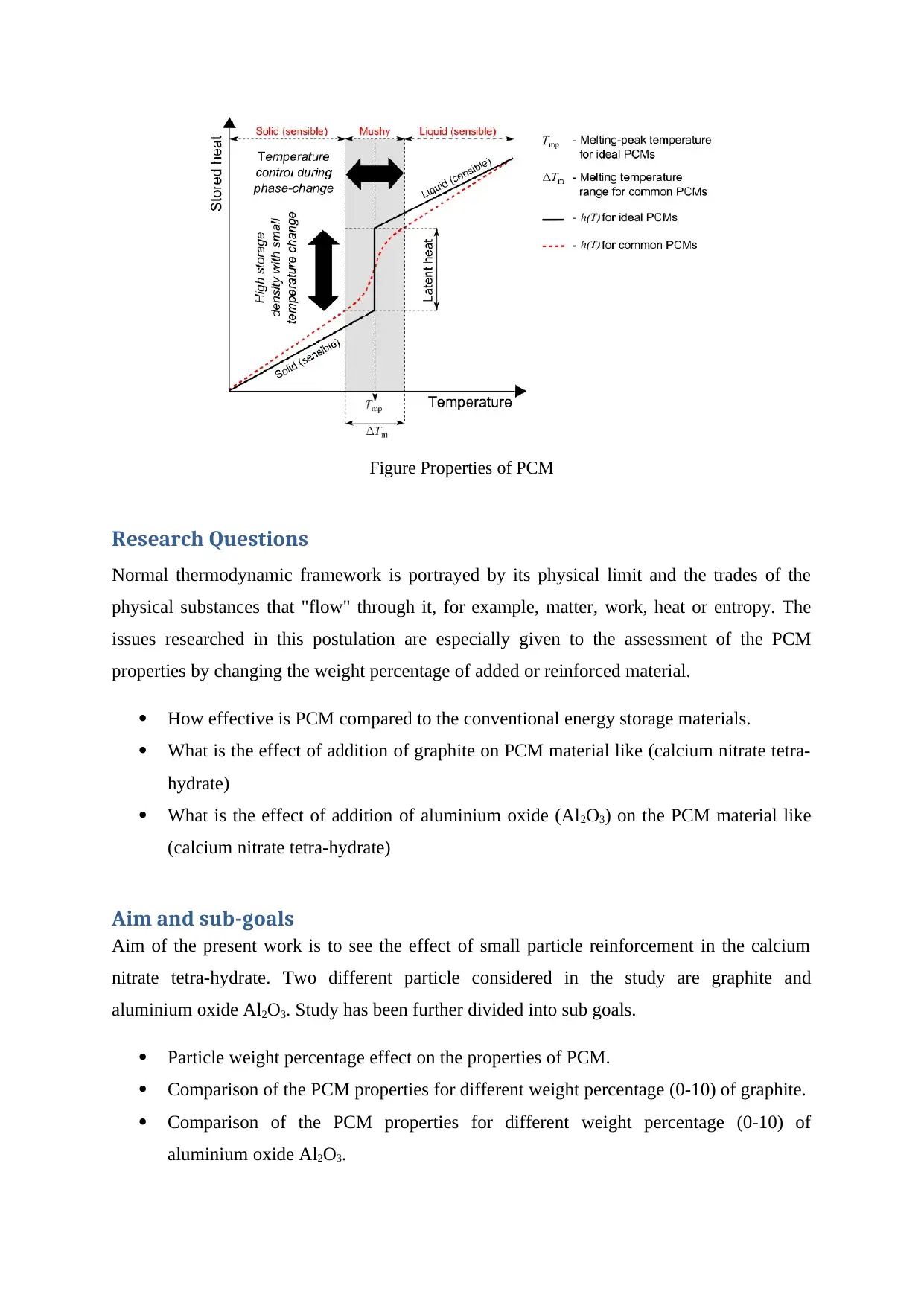
Figure Properties of PCM
Research Questions
Normal thermodynamic framework is portrayed by its physical limit and the trades of the
physical substances that "flow" through it, for example, matter, work, heat or entropy. The
issues researched in this postulation are especially given to the assessment of the PCM
properties by changing the weight percentage of added or reinforced material.
How effective is PCM compared to the conventional energy storage materials.
What is the effect of addition of graphite on PCM material like (calcium nitrate tetra-
hydrate)
What is the effect of addition of aluminium oxide (Al2O3) on the PCM material like
(calcium nitrate tetra-hydrate)
Aim and sub-goals
Aim of the present work is to see the effect of small particle reinforcement in the calcium
nitrate tetra-hydrate. Two different particle considered in the study are graphite and
aluminium oxide Al2O3. Study has been further divided into sub goals.
Particle weight percentage effect on the properties of PCM.
Comparison of the PCM properties for different weight percentage (0-10) of graphite.
Comparison of the PCM properties for different weight percentage (0-10) of
aluminium oxide Al2O3.
Research Questions
Normal thermodynamic framework is portrayed by its physical limit and the trades of the
physical substances that "flow" through it, for example, matter, work, heat or entropy. The
issues researched in this postulation are especially given to the assessment of the PCM
properties by changing the weight percentage of added or reinforced material.
How effective is PCM compared to the conventional energy storage materials.
What is the effect of addition of graphite on PCM material like (calcium nitrate tetra-
hydrate)
What is the effect of addition of aluminium oxide (Al2O3) on the PCM material like
(calcium nitrate tetra-hydrate)
Aim and sub-goals
Aim of the present work is to see the effect of small particle reinforcement in the calcium
nitrate tetra-hydrate. Two different particle considered in the study are graphite and
aluminium oxide Al2O3. Study has been further divided into sub goals.
Particle weight percentage effect on the properties of PCM.
Comparison of the PCM properties for different weight percentage (0-10) of graphite.
Comparison of the PCM properties for different weight percentage (0-10) of
aluminium oxide Al2O3.
⊘ This is a preview!⊘
Do you want full access?
Subscribe today to unlock all pages.

Trusted by 1+ million students worldwide
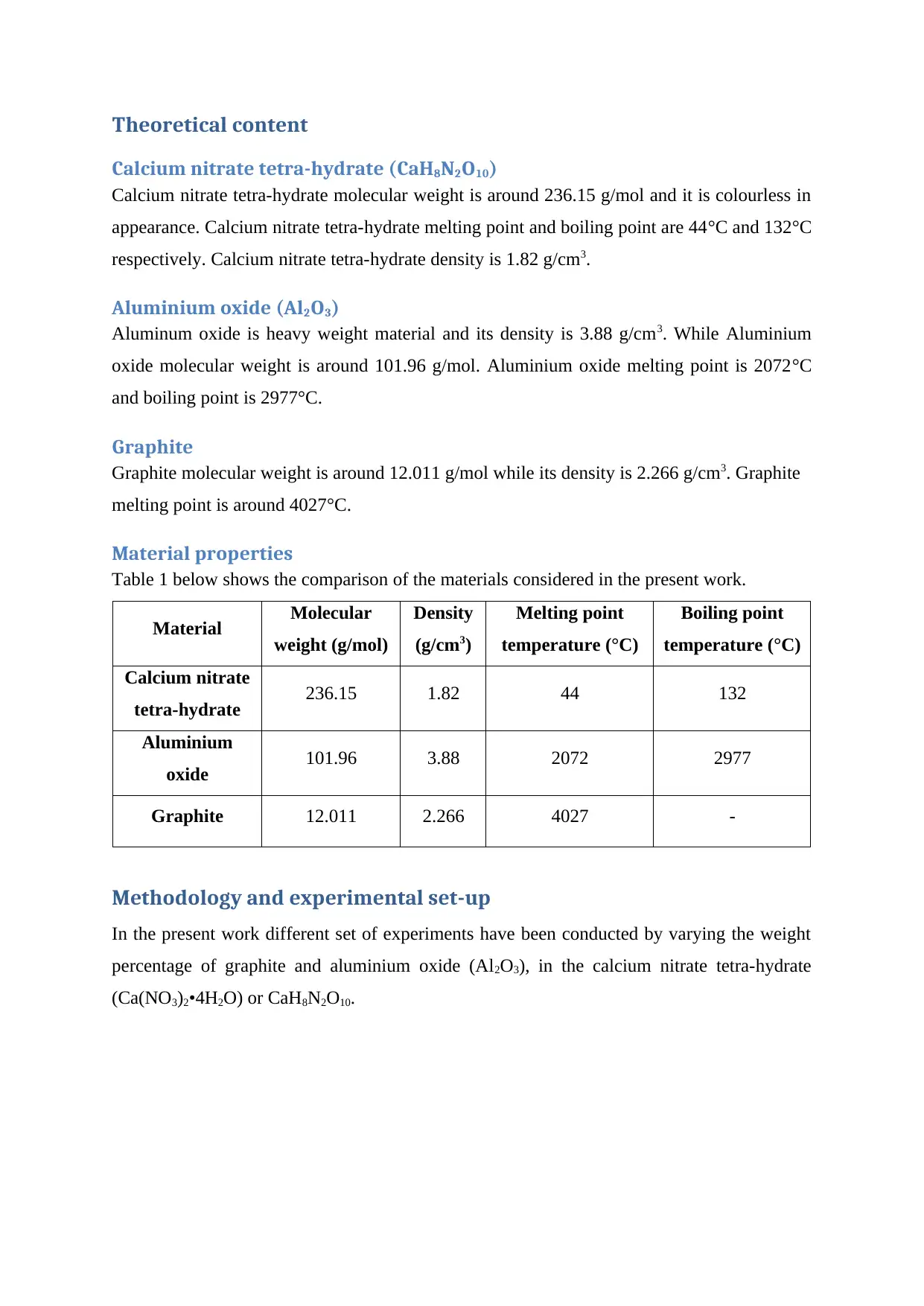
Theoretical content
Calcium nitrate tetra-hydrate (CaH8N2O10)
Calcium nitrate tetra-hydrate molecular weight is around 236.15 g/mol and it is colourless in
appearance. Calcium nitrate tetra-hydrate melting point and boiling point are 44°C and 132°C
respectively. Calcium nitrate tetra-hydrate density is 1.82 g/cm3.
Aluminium oxide (Al2O3)
Aluminum oxide is heavy weight material and its density is 3.88 g/cm3. While Aluminium
oxide molecular weight is around 101.96 g/mol. Aluminium oxide melting point is 2072°C
and boiling point is 2977°C.
Graphite
Graphite molecular weight is around 12.011 g/mol while its density is 2.266 g/cm3. Graphite
melting point is around 4027°C.
Material properties
Table 1 below shows the comparison of the materials considered in the present work.
Material Molecular
weight (g/mol)
Density
(g/cm3)
Melting point
temperature (°C)
Boiling point
temperature (°C)
Calcium nitrate
tetra-hydrate 236.15 1.82 44 132
Aluminium
oxide 101.96 3.88 2072 2977
Graphite 12.011 2.266 4027 -
Methodology and experimental set-up
In the present work different set of experiments have been conducted by varying the weight
percentage of graphite and aluminium oxide (Al2O3), in the calcium nitrate tetra-hydrate
(Ca(NO3)2•4H2O) or CaH8N2O10.
Calcium nitrate tetra-hydrate (CaH8N2O10)
Calcium nitrate tetra-hydrate molecular weight is around 236.15 g/mol and it is colourless in
appearance. Calcium nitrate tetra-hydrate melting point and boiling point are 44°C and 132°C
respectively. Calcium nitrate tetra-hydrate density is 1.82 g/cm3.
Aluminium oxide (Al2O3)
Aluminum oxide is heavy weight material and its density is 3.88 g/cm3. While Aluminium
oxide molecular weight is around 101.96 g/mol. Aluminium oxide melting point is 2072°C
and boiling point is 2977°C.
Graphite
Graphite molecular weight is around 12.011 g/mol while its density is 2.266 g/cm3. Graphite
melting point is around 4027°C.
Material properties
Table 1 below shows the comparison of the materials considered in the present work.
Material Molecular
weight (g/mol)
Density
(g/cm3)
Melting point
temperature (°C)
Boiling point
temperature (°C)
Calcium nitrate
tetra-hydrate 236.15 1.82 44 132
Aluminium
oxide 101.96 3.88 2072 2977
Graphite 12.011 2.266 4027 -
Methodology and experimental set-up
In the present work different set of experiments have been conducted by varying the weight
percentage of graphite and aluminium oxide (Al2O3), in the calcium nitrate tetra-hydrate
(Ca(NO3)2•4H2O) or CaH8N2O10.
Paraphrase This Document
Need a fresh take? Get an instant paraphrase of this document with our AI Paraphraser
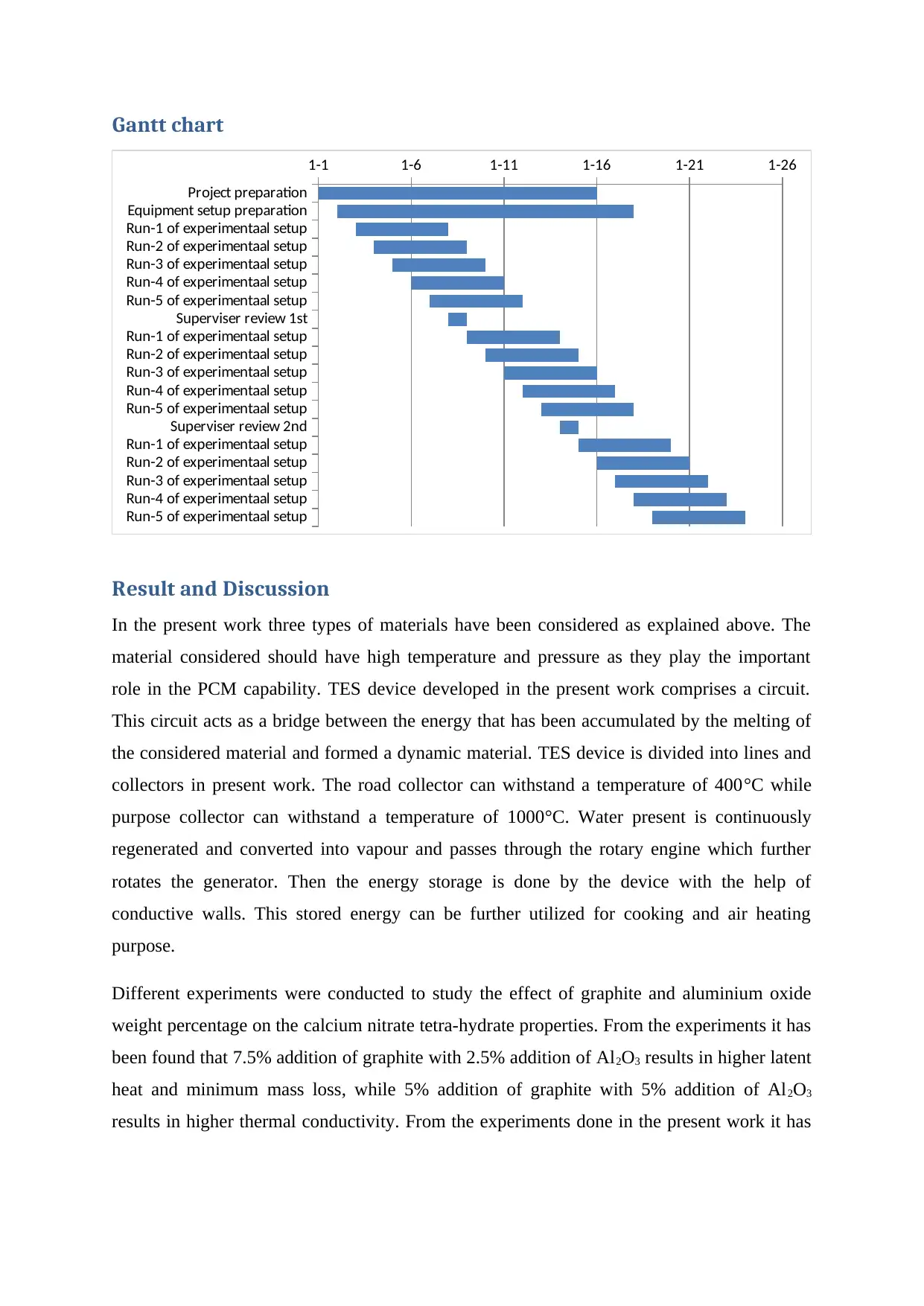
Gantt chart
Project preparation
Equipment setup preparation
Run-1 of experimentaal setup
Run-2 of experimentaal setup
Run-3 of experimentaal setup
Run-4 of experimentaal setup
Run-5 of experimentaal setup
Superviser review 1st
Run-1 of experimentaal setup
Run-2 of experimentaal setup
Run-3 of experimentaal setup
Run-4 of experimentaal setup
Run-5 of experimentaal setup
Superviser review 2nd
Run-1 of experimentaal setup
Run-2 of experimentaal setup
Run-3 of experimentaal setup
Run-4 of experimentaal setup
Run-5 of experimentaal setup
1-1 1-6 1-11 1-16 1-21 1-26
Result and Discussion
In the present work three types of materials have been considered as explained above. The
material considered should have high temperature and pressure as they play the important
role in the PCM capability. TES device developed in the present work comprises a circuit.
This circuit acts as a bridge between the energy that has been accumulated by the melting of
the considered material and formed a dynamic material. TES device is divided into lines and
collectors in present work. The road collector can withstand a temperature of 400°C while
purpose collector can withstand a temperature of 1000°C. Water present is continuously
regenerated and converted into vapour and passes through the rotary engine which further
rotates the generator. Then the energy storage is done by the device with the help of
conductive walls. This stored energy can be further utilized for cooking and air heating
purpose.
Different experiments were conducted to study the effect of graphite and aluminium oxide
weight percentage on the calcium nitrate tetra-hydrate properties. From the experiments it has
been found that 7.5% addition of graphite with 2.5% addition of Al2O3 results in higher latent
heat and minimum mass loss, while 5% addition of graphite with 5% addition of Al2O3
results in higher thermal conductivity. From the experiments done in the present work it has
Project preparation
Equipment setup preparation
Run-1 of experimentaal setup
Run-2 of experimentaal setup
Run-3 of experimentaal setup
Run-4 of experimentaal setup
Run-5 of experimentaal setup
Superviser review 1st
Run-1 of experimentaal setup
Run-2 of experimentaal setup
Run-3 of experimentaal setup
Run-4 of experimentaal setup
Run-5 of experimentaal setup
Superviser review 2nd
Run-1 of experimentaal setup
Run-2 of experimentaal setup
Run-3 of experimentaal setup
Run-4 of experimentaal setup
Run-5 of experimentaal setup
1-1 1-6 1-11 1-16 1-21 1-26
Result and Discussion
In the present work three types of materials have been considered as explained above. The
material considered should have high temperature and pressure as they play the important
role in the PCM capability. TES device developed in the present work comprises a circuit.
This circuit acts as a bridge between the energy that has been accumulated by the melting of
the considered material and formed a dynamic material. TES device is divided into lines and
collectors in present work. The road collector can withstand a temperature of 400°C while
purpose collector can withstand a temperature of 1000°C. Water present is continuously
regenerated and converted into vapour and passes through the rotary engine which further
rotates the generator. Then the energy storage is done by the device with the help of
conductive walls. This stored energy can be further utilized for cooking and air heating
purpose.
Different experiments were conducted to study the effect of graphite and aluminium oxide
weight percentage on the calcium nitrate tetra-hydrate properties. From the experiments it has
been found that 7.5% addition of graphite with 2.5% addition of Al2O3 results in higher latent
heat and minimum mass loss, while 5% addition of graphite with 5% addition of Al2O3
results in higher thermal conductivity. From the experiments done in the present work it has
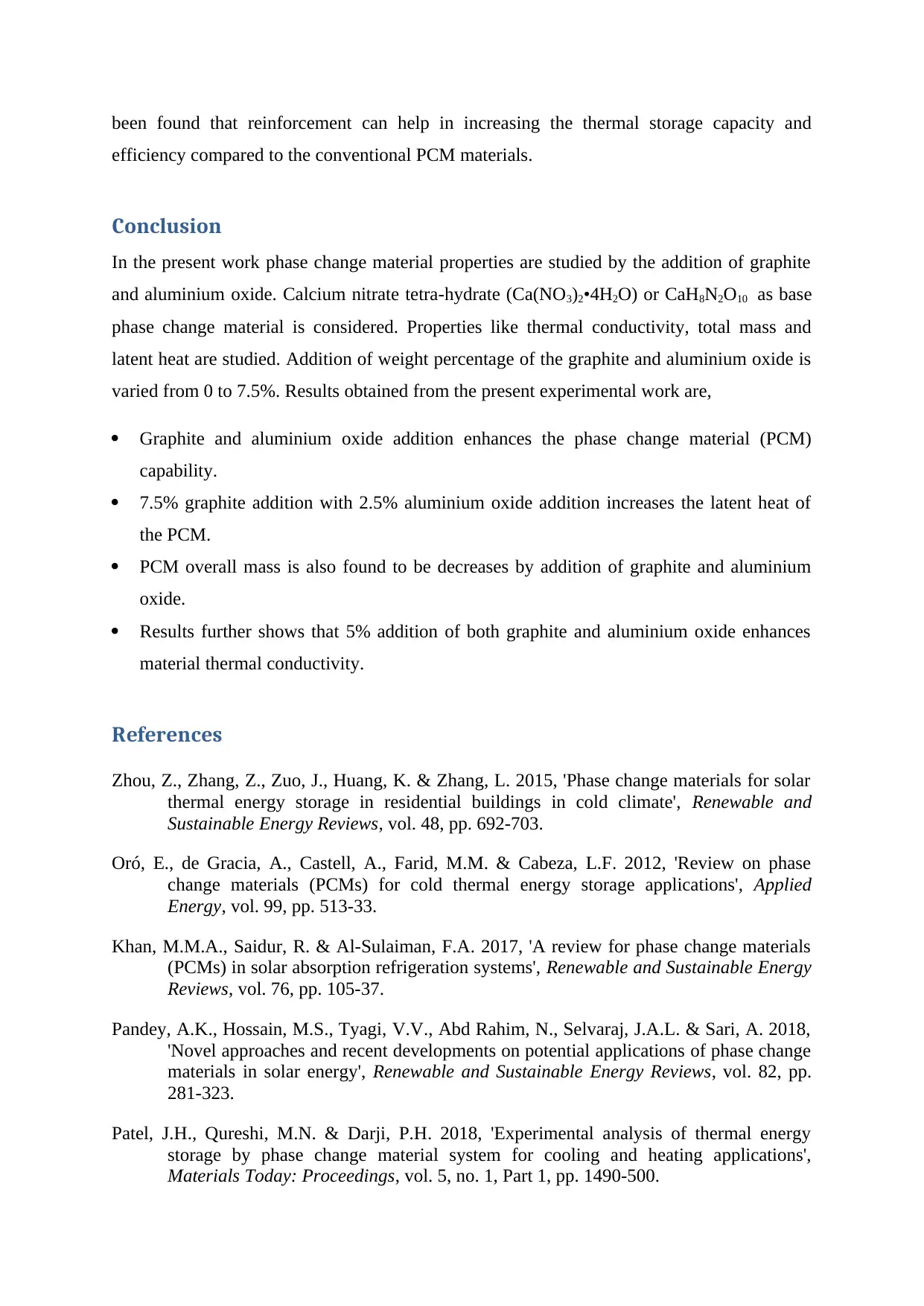
been found that reinforcement can help in increasing the thermal storage capacity and
efficiency compared to the conventional PCM materials.
Conclusion
In the present work phase change material properties are studied by the addition of graphite
and aluminium oxide. Calcium nitrate tetra-hydrate (Ca(NO3)2•4H2O) or CaH8N2O10 as base
phase change material is considered. Properties like thermal conductivity, total mass and
latent heat are studied. Addition of weight percentage of the graphite and aluminium oxide is
varied from 0 to 7.5%. Results obtained from the present experimental work are,
Graphite and aluminium oxide addition enhances the phase change material (PCM)
capability.
7.5% graphite addition with 2.5% aluminium oxide addition increases the latent heat of
the PCM.
PCM overall mass is also found to be decreases by addition of graphite and aluminium
oxide.
Results further shows that 5% addition of both graphite and aluminium oxide enhances
material thermal conductivity.
References
Zhou, Z., Zhang, Z., Zuo, J., Huang, K. & Zhang, L. 2015, 'Phase change materials for solar
thermal energy storage in residential buildings in cold climate', Renewable and
Sustainable Energy Reviews, vol. 48, pp. 692-703.
Oró, E., de Gracia, A., Castell, A., Farid, M.M. & Cabeza, L.F. 2012, 'Review on phase
change materials (PCMs) for cold thermal energy storage applications', Applied
Energy, vol. 99, pp. 513-33.
Khan, M.M.A., Saidur, R. & Al-Sulaiman, F.A. 2017, 'A review for phase change materials
(PCMs) in solar absorption refrigeration systems', Renewable and Sustainable Energy
Reviews, vol. 76, pp. 105-37.
Pandey, A.K., Hossain, M.S., Tyagi, V.V., Abd Rahim, N., Selvaraj, J.A.L. & Sari, A. 2018,
'Novel approaches and recent developments on potential applications of phase change
materials in solar energy', Renewable and Sustainable Energy Reviews, vol. 82, pp.
281-323.
Patel, J.H., Qureshi, M.N. & Darji, P.H. 2018, 'Experimental analysis of thermal energy
storage by phase change material system for cooling and heating applications',
Materials Today: Proceedings, vol. 5, no. 1, Part 1, pp. 1490-500.
efficiency compared to the conventional PCM materials.
Conclusion
In the present work phase change material properties are studied by the addition of graphite
and aluminium oxide. Calcium nitrate tetra-hydrate (Ca(NO3)2•4H2O) or CaH8N2O10 as base
phase change material is considered. Properties like thermal conductivity, total mass and
latent heat are studied. Addition of weight percentage of the graphite and aluminium oxide is
varied from 0 to 7.5%. Results obtained from the present experimental work are,
Graphite and aluminium oxide addition enhances the phase change material (PCM)
capability.
7.5% graphite addition with 2.5% aluminium oxide addition increases the latent heat of
the PCM.
PCM overall mass is also found to be decreases by addition of graphite and aluminium
oxide.
Results further shows that 5% addition of both graphite and aluminium oxide enhances
material thermal conductivity.
References
Zhou, Z., Zhang, Z., Zuo, J., Huang, K. & Zhang, L. 2015, 'Phase change materials for solar
thermal energy storage in residential buildings in cold climate', Renewable and
Sustainable Energy Reviews, vol. 48, pp. 692-703.
Oró, E., de Gracia, A., Castell, A., Farid, M.M. & Cabeza, L.F. 2012, 'Review on phase
change materials (PCMs) for cold thermal energy storage applications', Applied
Energy, vol. 99, pp. 513-33.
Khan, M.M.A., Saidur, R. & Al-Sulaiman, F.A. 2017, 'A review for phase change materials
(PCMs) in solar absorption refrigeration systems', Renewable and Sustainable Energy
Reviews, vol. 76, pp. 105-37.
Pandey, A.K., Hossain, M.S., Tyagi, V.V., Abd Rahim, N., Selvaraj, J.A.L. & Sari, A. 2018,
'Novel approaches and recent developments on potential applications of phase change
materials in solar energy', Renewable and Sustainable Energy Reviews, vol. 82, pp.
281-323.
Patel, J.H., Qureshi, M.N. & Darji, P.H. 2018, 'Experimental analysis of thermal energy
storage by phase change material system for cooling and heating applications',
Materials Today: Proceedings, vol. 5, no. 1, Part 1, pp. 1490-500.
⊘ This is a preview!⊘
Do you want full access?
Subscribe today to unlock all pages.

Trusted by 1+ million students worldwide
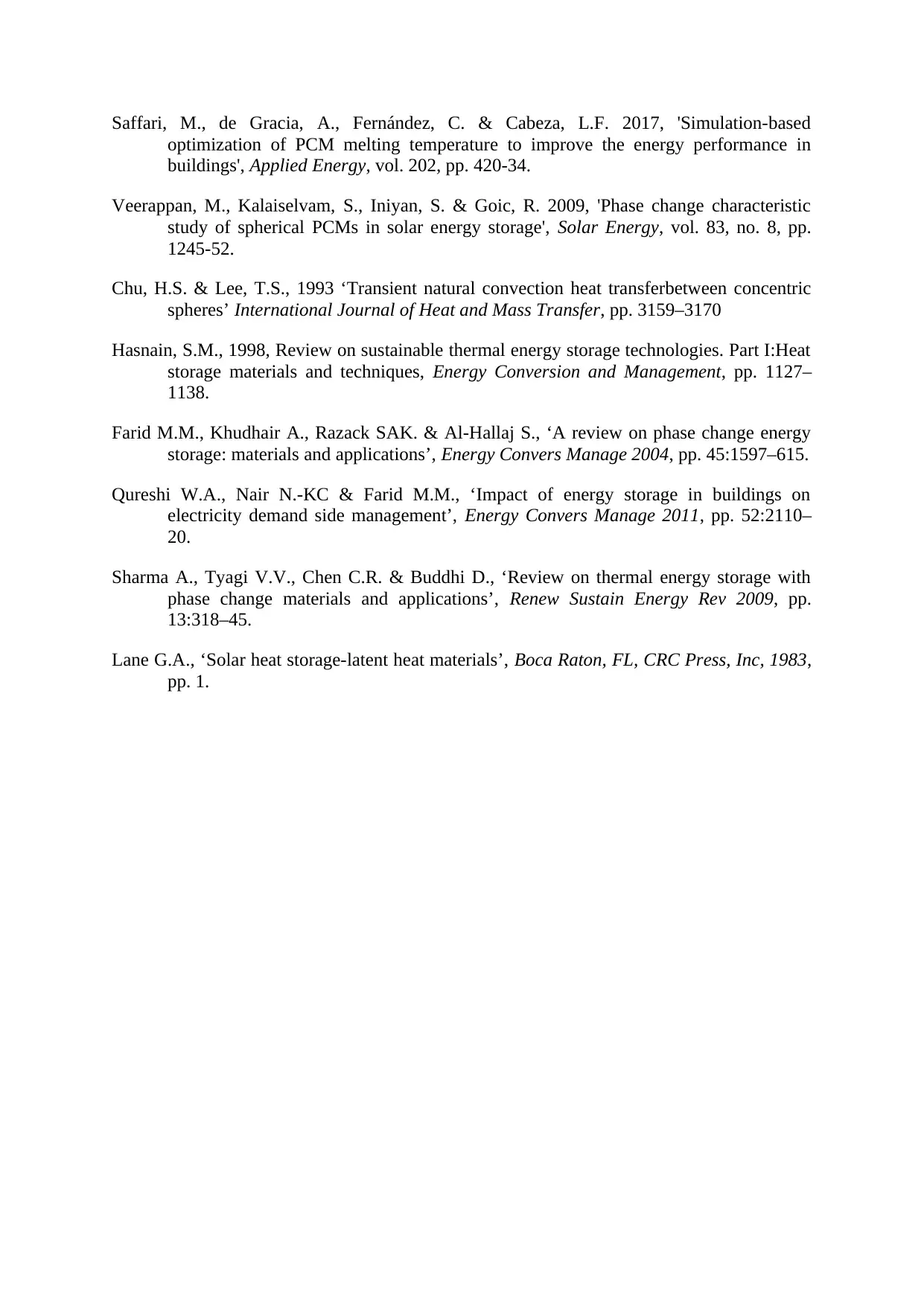
Saffari, M., de Gracia, A., Fernández, C. & Cabeza, L.F. 2017, 'Simulation-based
optimization of PCM melting temperature to improve the energy performance in
buildings', Applied Energy, vol. 202, pp. 420-34.
Veerappan, M., Kalaiselvam, S., Iniyan, S. & Goic, R. 2009, 'Phase change characteristic
study of spherical PCMs in solar energy storage', Solar Energy, vol. 83, no. 8, pp.
1245-52.
Chu, H.S. & Lee, T.S., 1993 ‘Transient natural convection heat transferbetween concentric
spheres’ International Journal of Heat and Mass Transfer, pp. 3159–3170
Hasnain, S.M., 1998, Review on sustainable thermal energy storage technologies. Part I:Heat
storage materials and techniques, Energy Conversion and Management, pp. 1127–
1138.
Farid M.M., Khudhair A., Razack SAK. & Al-Hallaj S., ‘A review on phase change energy
storage: materials and applications’, Energy Convers Manage 2004, pp. 45:1597–615.
Qureshi W.A., Nair N.-KC & Farid M.M., ‘Impact of energy storage in buildings on
electricity demand side management’, Energy Convers Manage 2011, pp. 52:2110–
20.
Sharma A., Tyagi V.V., Chen C.R. & Buddhi D., ‘Review on thermal energy storage with
phase change materials and applications’, Renew Sustain Energy Rev 2009, pp.
13:318–45.
Lane G.A., ‘Solar heat storage-latent heat materials’, Boca Raton, FL, CRC Press, Inc, 1983,
pp. 1.
optimization of PCM melting temperature to improve the energy performance in
buildings', Applied Energy, vol. 202, pp. 420-34.
Veerappan, M., Kalaiselvam, S., Iniyan, S. & Goic, R. 2009, 'Phase change characteristic
study of spherical PCMs in solar energy storage', Solar Energy, vol. 83, no. 8, pp.
1245-52.
Chu, H.S. & Lee, T.S., 1993 ‘Transient natural convection heat transferbetween concentric
spheres’ International Journal of Heat and Mass Transfer, pp. 3159–3170
Hasnain, S.M., 1998, Review on sustainable thermal energy storage technologies. Part I:Heat
storage materials and techniques, Energy Conversion and Management, pp. 1127–
1138.
Farid M.M., Khudhair A., Razack SAK. & Al-Hallaj S., ‘A review on phase change energy
storage: materials and applications’, Energy Convers Manage 2004, pp. 45:1597–615.
Qureshi W.A., Nair N.-KC & Farid M.M., ‘Impact of energy storage in buildings on
electricity demand side management’, Energy Convers Manage 2011, pp. 52:2110–
20.
Sharma A., Tyagi V.V., Chen C.R. & Buddhi D., ‘Review on thermal energy storage with
phase change materials and applications’, Renew Sustain Energy Rev 2009, pp.
13:318–45.
Lane G.A., ‘Solar heat storage-latent heat materials’, Boca Raton, FL, CRC Press, Inc, 1983,
pp. 1.
1 out of 10
Your All-in-One AI-Powered Toolkit for Academic Success.
+13062052269
info@desklib.com
Available 24*7 on WhatsApp / Email
![[object Object]](/_next/static/media/star-bottom.7253800d.svg)
Unlock your academic potential
Copyright © 2020–2025 A2Z Services. All Rights Reserved. Developed and managed by ZUCOL.